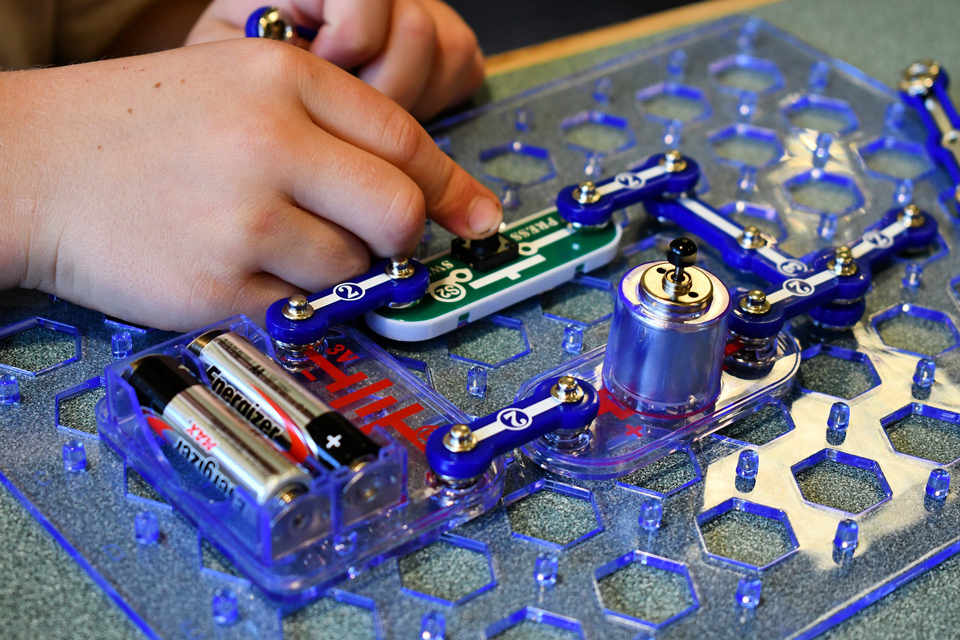Although many schools, in a bid to raise achievement in compulsory subjects, have cut GCSE Design & Technology from their syllabus, it’s the subject that brings all of STEM together! In fact, DT has moved on from the days when the goal was to make a simple wooden clock or metal coat-hook, without discussion about why they are being made, or a follow-up with more complex creations. Nowadays, you only have to talk about concepts such as 3D printing, London’s Millennium Bridge, the Bloodhound car or robots for children, to see how Design and Technology is exciting and very relevant!
The UK has a shortfall of skilled engineers and, with problem solving abilities in demand, it’s vital that children with high learning potential, who are interested in STEM, become engaged with Design and Technology – they’ll develop conceptual ideas, use and deepen their curiosity and love of science but most of all, realise that engineering can be fun.
Many bright children will naturally be creative, have a logical mind or love problem solving. However, while a child may come up with brilliant ideas, creating an object can prove more of a challenge. They need to know about a product’s application as well as having technological understanding. Here are a few ways to get them engaged.
Have a Child Who Likes Maths But Not Design and Technology?
Applied mathematics is the key –ask your child for their practical thoughts on questions like:
- How does the Airbus A350 fly through the sky?
- How are skyscrapers built to stop them falling over in high winds?
- How many seconds does it take a car to stop?
All are impossible to solve without maths.
An At-Home Workshop
Let them loose on a cordless drill?! Okay, so we don’t mean that your child runs off to do what they want without guidance; however, this can be an excellent way for them to develop more independence, by letting them try out selected tools with supervision. Initially just practise using a tool on scrap wood, but then move onto making something using it.
Younger children could make a cardboard castle that is strong enough to take figures, such as knights and queens, drawing designs on the castle or making a zip wire between two “towers”, using Lego, kitchen roll cardboard and a spool of ribbon to connect the two points!
Textiles: Make and Remake
It’s the very fabric of a finished product! Textiles requires such skills as measurement, understanding of different fibre strengths and even chemistry.
Enjoy a simple sewing activity together, such as designing and making a bag or bookmark or try recycling pockets from an old item of clothing to make an iPod pouch. If your child gets frustrated with a lack of material or stitches going awry, help them to develop resilience through problem-solving how to fix it.
Electronics
Use a soldering iron to build something from electrical components, such as those at https://www.kitronik.co.uk/project-kits.html.
Home DIY
Challenge a child by supervising them as they change a plug or lightbulb, put up a shelf and help to prop up a ladder safely. Look together at the parts under a car bonnet and find out why and how they work. All traditional skills are useful, not just for their practical value, but also for a change of mindset. If you know how objects are made, you understand them at a deeper level and may also consider how they could be different.
Start with Simulation
The website Tinkercad, or free software like Blender, will make your budding engineer gasp as they can be used to turn the child’s design concept into something that looks real. Send the resulting file to a 3D printing company and it will be truly real.
Practise Communicating and Assessing Ideas
- Show an interest in new construction work and compare it with buildings from different periods.
- Evaluate products in a shop such as Apple or Lush.
- Spot and analyse new products, trends, and materials. Can your child think of the impact these products are making and the reasons behind them?
Higher Order Design
For older children: Discuss what they think a Smart City is (a city using many measurement devices to manage efficient use of limited resources) and design one; find an alternative to nuclear power; how would they optimise the UK rail network?
Internet of Things
This is a growth area of engineering: see if you can show or talk to your child about internet security, driverless cars, or medical technology used at home. How can an ordinary object develop “smart thinking”? What risks could it bring, such as hacking?
Venture Out
Consider trips to The Big Bang Fair (Birmingham), Engineer Your Future (London Science Museum, age 11-15), Ditchling Museum of Art and Craft (East Sussex), traditional craftsmen, the V&A Dundee, a manufacturing company such as Jaguar (12+ years) https://www.jaguar.co.uk/experience-jaguar/factory-tours/solihull.html or Sony http://www.sonypencoed.co.uk/educational-visits/. BAE Systems also host community group roadshows: https://www.baesystems.com/en/careers/careers-in-the-uk/
Crest Awards
This national scheme awards children and young adults for their STEM project work. https://www.crestawards.org/why-crest
Extras
- The Tomorrow’s Engineers website has a fun quiz which may get your child contemplating a future career: https://www.tomorrowsengineers.org.uk/students/meet-the-future-you-careers-quiz/
- For engineering activities: https://www.tomorrowsengineers.org.uk/careers-resources-activities/download-activities/
- A woman’s perspective on design: https://www.bbc.co.uk/news/av/world-50269778/what-would-a-city-designed-by-women-be-like
Cookery
Emulate the Big Family Cooking Showdown competition and get the whole family challenging each other to cook a two-course dinner. Encourage cookery skills such as cutting and shaping pastry, finishing techniques such as glazing with egg, and plate-up presentation. For the keen cook, let them link familiar ingredients with novel – what unusual ingredients can star, and why?
For older children, have a chat about designing meals for maximum health benefits, or responsible consumption. See PA702 Developing Critical Thinking Skills







